Record on the LUX experiment sensitivity and PandaX not yet caught dark matter particles
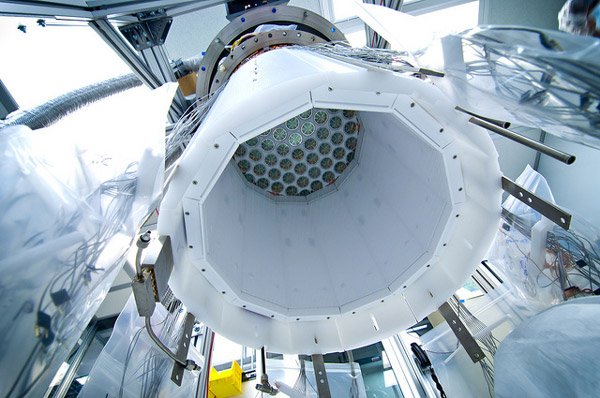
Working LUX detector capacitance, which is filled with liquid xenon
At the recently held conference Identification of Dark Matter two large team of experimentalists, LUX and PandaX, presented their new data on the direct search for dark matter particles. Despite the exceptional sensitivity settings, elusive particles have not been registered. Restrictions on top of the cross section improved to four times compared to the previous record, while they themselves are preparing for a new collaboration sessions observations.
The search for dark matter particles: general perspective
The search for dark matter particles - this is one of the critical problems in fundamental physics, the problem, which clashed in two areas of modern science - the physics of the microworld and cosmology. According to astronomical observations, in addition to the universe of stars, planets, gas and dust clouds, and there are a lot of dark matter - matter that we can not see directly in any region of the electromagnetic spectrum, but that "a handful" in the galaxies and their clusters. This matter must consist of particles of a new variety, which has no place in the Standard Model of elementary particles. But what kind of particles as well as their weight, they are taken from a new physics theory - is still unknown. We only know that these particles in space a lot, and that the solar system, in its flight through the galaxy, feeling counter "dark wind ', which passes through, including the Earth. The search for dark matter particles - is an attempt to capture at least some of the events of the scattering particles in the atoms of underground detectors.
Prospects for the detection of dark matter particles are critically dependent on two parameters: mass and cross section of scattering on the atoms of ordinary matter. Both parameters are unknown and may be in a very wide range. The fact that physics has not yet caught dark matter particles, allowing only set an upper limit on the cross section for different masses, but can not completely eliminate any range of their values.
In principle, some help can come from theory. Theorists have developed hundreds of new physics models in which there is a place and a particle-candidates for dark matter. The most popular - the so-called WIMPs, hypothetical weakly interacting heavy particles with masses of the order of hundreds of GeV or TeV. However, since none of the theories has not yet received a clear experimental confirmation of their predictions still remain ephemeral.
As a result of many decades between theoreticians and experimentalists is a kind of "game of hide and seek." Theorists suggest the next model of the new physics, which predicts that the detectors is about to find dark matter. Experimenters make another heroic effort, at times increase the sensitivity of their detectors - and find nothing. Theorists, taking into account these figures and the results coming from the colliders, put forward an improved model, in which once again predicted the possibility of dark matter particle detectors at the limit of sensitivity. Experimenters make another breakthrough - but again did not find anything.
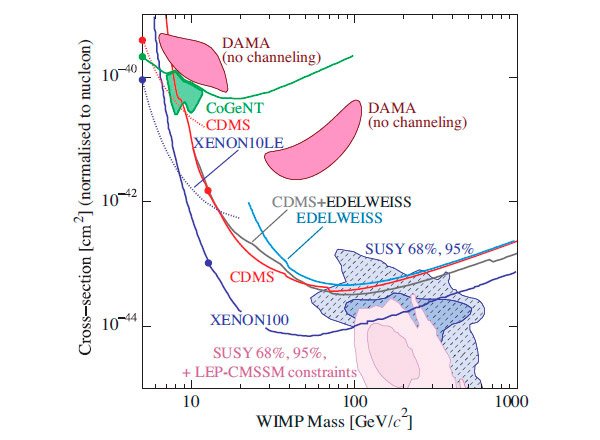
Summary of 2012 results of experiments to find in the mass of dark matter particles to 1 TeV and predictions of supersymmetric models. Colored lines - upper limit on the cross section obtained in experiments with negative results; bright spots - the range of parameters that are indicated experiments with positive results; bright spots in the bottom of the chart - the theoretical predictions
However, in the last decade or so there was little enthusiasm in the field. The sensitivity of the detectors has stolen up to the area in the plane of parameters, at which point many theoretical constructions, including different versions of supersymmetric models - and they have always held in high esteem theorists. This mass region of several hundred GeV and scattering cross sections of the order of 1 zeptobarna (1 ST = 10-45 cm2). See Fig. 2. The new particle of mass is just expected on the eve of the launch of the Large Hadron Collider, and, by a happy coincidence, that this range the most sensitive detectors. So physicists hoped that another experimental breakthrough technology will finally reach the cherished elusive particles.
The last three years
To increase the chances of catching dark matter particles, it is necessary to take a bigger detector, put it in conditions where there is no extraneous signals, and a long time to sit and wait. Therefore, the two key characteristics of dark matter detectors - a total exposure (ie, the mass of sensitive material, multiplied by time, usually measured in kg · days) and the expected rate of false positives (it relies on the screening of cosmic rays, the use sverhradiochistyh materials and reliable separation algorithms background and signaling events). If a decade ago, the typical weight is weight, and the rate of background processes remained quite large, but now the detectors are already working with hundreds of kilograms of sensitive material, and the number of false positives is not more than a few a year, and sometimes even fall to zero.
In recent years, "lead from the front" appeared regularly in popular science news (see. A brief overview). Of the latter, the most significant update was the announcement of the first results of the LUX experiment, the most sensitive dark matter detectors weighing up to a ton (LUX experiment has not yet found dark matter particles, "Elements", 31.10.2013). This installation was launched in mid-2013, and the first session of the work pure observing time was 85 days. The mass of the working substance in the central, most reliable detector for the analysis of the area (fiducial volume) amounted to 118 kg, which gave a complete exposition of 10,000 kg · day. In late October, the processed data of this session, given the result of physics: dark matter is still to be seen, but a new upper limit on the interaction cross-section compared with the previous record holder, XENON100 experiment, has been improved in two or more times.
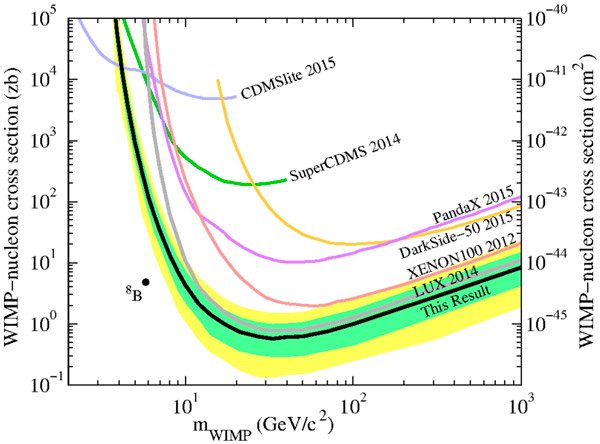
The upper limit on the spin-independent scattering cross section of dark matter particles with a mass of 2 to 1000 GeV per nucleon. LUX Curve 2014 - initial results LUX according to the first session in 2013; black thick line - the result of the updated analysis of the same data; green and yellow stripes - areas in which, as expected based on the modeling was to pass the curve. Other colored lines - the results of other experiments to search for dark matter particles. The graph of article D. S. Akerib et al., 2016.
It is interesting that, although the publication of this data from the LUX came in early 2014, members continued collaboration to optimize the data processing methodology and evaluation of the background processes. Since that time, they have learned to better calibrate the detector (especially with the help of a new technique that uses the beta decay of tritium, see .: DS Akerib et al., 2016. Tritium calibration of the LUX dark matter experiment), optimized algorithm Event recovery, We gained experience in understanding the background events caused by processes on the walls of the working volume. All this has allowed them to improve the sensitivity of the detector by about 20% for heavy particles of dark matter, and at times - in the mass range below 10 GeV (Figure 3.). The lower limit of sensitivity moved below 4 GeV, which was originally for xenon detectors are not anticipated. Article from the final analysis of the 2013 data year, and already with an exposure of 14 thousand kg · day was published as recently as April this year (DS Akerib et al., 2016. Improved Limits on Scattering of Weakly Interacting Massive Particles from Reanalysis of 2013 LUX Data) .
New results
From a technical point of view, the first results of LUX demonstrated excellent performance and installation data analysis algorithms, so only had to be patient and continue to the dataset. LUX new session started 11 September 2014 and was completed this year, on May 3. Net observing time during this period was 332 days, as from time to time of observation sessions were interspersed with regular calibration of the detector. The volume of the detector secure area was selected slightly smaller, giving a weight of about 100 kg, and the total exposure over the entire observation session was 33,500 kg · day. However, it is three times higher than the exposure of the first session.
Parallel to this, we continued to build, develop, and gradually withdraw from the shadows LUX other detectors for dark matter particles. So, Chinese PandaX detector is also used as a sensitive substance liquid xenon, held in 2014, a modest first session and set the upper limit, which was still an order of magnitude inferior to the results of LUX. However, in the past, physicists have significantly increased the volume of the installation, greatly reduced background, and from March to June 2016 conducted a new session dataset (PandaX-II, Run 9). Thanks to more than the LUX, the mass of the working substance (gross weight - half a ton, reliable - 300 kg), the total exposure PandaX-II in such a short time caught up with LUX and totaled 33.2 thousand kg · day.
The Conference Identification of Dark Matter, which took place from 18 to 22 July in Sheffield, United Kingdom, both groups have presented preliminary data from their last sessions. Both detectors have registered several hundred (PandaX) and thousands (LUX)-candidate events, but they are all either demonstrated characteristics typical radioisotope decays, a place near the borders of the detector. only one has passed all the selection criteria Of all the events PandaX, - and then, it was on the verge of acceptable. In the case of LUX after dropping out the background at all, not a single event in the signal area. Thus, dark matter particles were not found in none of these experiments on the record sensitivity.
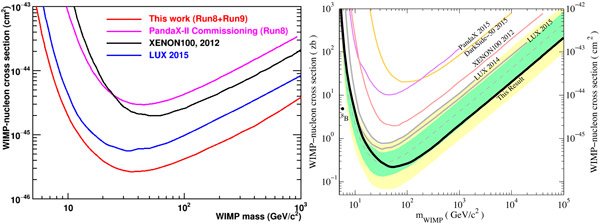
The new upper limit on the spin-independent scattering cross-section according to the first session of the Supervisory PandaX-II (left) and the full two-year session LUX (right).
The negative results of both experiments allowed to establish more stringent restrictions on top of the scattering cross section of dark matter particles by nucleons (Fig. 4). The illustrated curves correspond to the assumption that the scattering cross section does not depend on the spin; Both collaborations promise to show in the future and restrictions on the spin-dependent cross section. Experiment PandaX-II twice improved the previous result LUX (Fig. 4, left), but LUX collaboration immediately interrupted this achievement (Fig. 4, right). The most severe limitation has been found for the masses of the order of 40-50 GeV and was 0.27 for the ST PandaX-II and ST to 0.22 LUX. For heavier particles, with a mass of 200-300 GeV, both experimental closed-section of more than 1 ST. If we now look back at Fig. 2, we can see that the installation and PandaX LUX intruded deep into the area of predictions of supersymmetric theories and began to ruthlessly shut the essential pieces of the expected parameter space.
Plans for the coming years
As for the plans for the future, then there is still ample room for improvement. Firstly, PandaX-II continue dataset and increase exposure collected several times. Second, a set of data has started a new experiment XENON1T, too xenon detector with the mass of the working substance in a safe volume detector per ton in March this year. At this scale physics expect 2018 to go down the scale sections of another order of magnitude, up to 0.02 ST, and a few years - to reach 0,002 ST. Finally, although the LUX experiment completed its work, in collaboration already has plans for substantial upgrading of the installation (D. S. Akerib et al., 2016. LUX-ZEPLIN (LZ) Conceptual Design Report). LZ New detector will contain as much as 10 tons of liquid xenon (5 tons - in a safe volume of the detector), and when it enters service in 2020, he will become the most sensitive setting to find heavy dark matter particles.
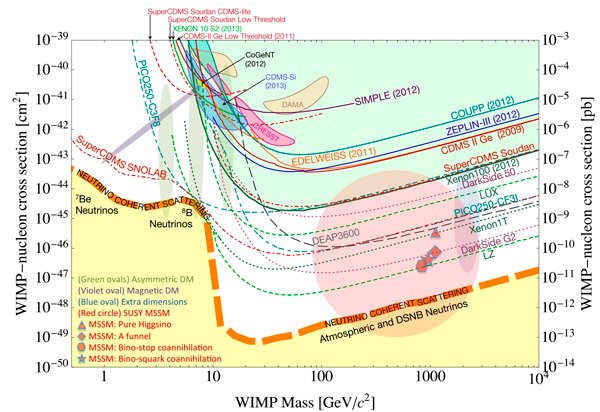
Achieved and planned (as of 2013) upper limit on the cross section for the scattering of dark matter particle with ordinary matter.
Fig. 5 summarizes achieved and expected upper limits in the mass order GeV and TeV. It is evident that with further increase in exposure will be to strengthen the current restrictions on the order of 2-3 - it is only for appliances. But then on the way to an increase in sensitivity will fall more serious obstacle - coherent scattering of neutrinos of different origin (solar, atmospheric, space) at the atomic nuclei. Join this scattering, of course, interesting in itself, but to search for the problem of dark matter particles, it will be the background. How to distinguish it from the expected signal - complex and not yet solved the problem. Now she is not very relevant, but if still will not be seen for the next decade of dark matter particles, this technical problem will arise in full growth.
Sources:
- Aaron Manalaysay (for the LUX Collaboration), Dark-matter results from 332 new live days of LUX data // report to the Conference Identification of Dark Matter (18-22 July, Sheffield, UK), PDF, 14 MB.
- Xiangdong Ji (for PandaX Collaboration), First DM Search Result from the PandaX-II 500kg LXe Detector // Ibid, PDF, 2,6 Mb.